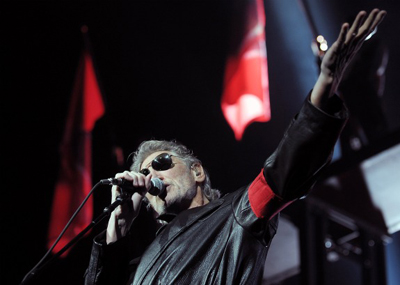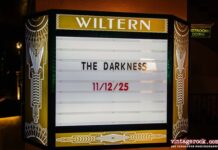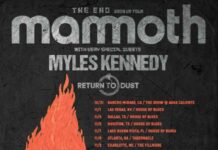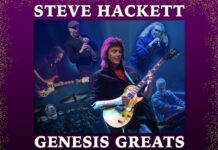Review by Shawn Perry
The Wall came rumbling into my life once again. The first time was in ‘79, around about the time the album popped out and clouded my optimism. I like to think it helped me get through college. The next year, I saw Pink Floyd play The Wall at the L.A Sports Arena. A couple of years after that, The Wall was on the big screen and I watched it repeatedly. Roger Waters restaged it with special guests in Berlin in 1990, but it didn’t quite make it for me. No one, not even Van Morrison, can sing “Comfortably Numb” quite as profoundly as David Gilmour.
In 2000, live recordings from Pink Floyd’s 1980 performances were released, perpetuating the hope that live video footage from the tour would follow. That has yet to materialize in any official capacity. I possess watchable bootlegs of both the Nassau Coliseum and Earl’s Court shows, but neither quite capture the wallop of being there. Bits and pieces from Earl’s Court showed up in a documentary called Behind The Wall, but that’s pretty much the extent of it.
But The Wall lives on. Waters has worked relentlessly at establishing it as its own — a piece that lives or dies with or without Pink Floyd. There was talk of a Broadway show (hey, it worked for Tommy), but that’s as far as that went. After Waters took The Dark Side Of The Moon on the road, it seemed only logical he should do the same with The Wall. The technology was finally in place to make it road-worthy — far more than the four-city, 29-performance marathon of 1980. Waters restaged the live presentation with a few new twists and detours, punching up its anti-war stance to give it a contemporary edge whilst retaining the original message of overall alienation.
Thirty years later, and The Wall was back up in my neighborhood — Southern California. Roger Waters traversed back and forth through these parts for a couple of weeks, and I managed to grab seats to shows at both the Staples Center and the Honda Center in Anaheim, the last stop of the U.S. tour.
The wall under construction for this tour doesn’t seem as wide as the one Pink Floyd used, but apparently it’s bigger, leaner and higher tech. As I was to find out, Waters used every prop and gimmick that appeared in the Floyd production, but also went to considerable lengths to update everything with better graphics and video playback. The lights dimmed and a game of musical chairs with dialog from the film Spartacus disrupted the anticipation, a more disfigured opening than the bumblings of a rambling announcer.
Instead of employing a surrogate band for the opening, a viable group of musicians played the entire show — drummer Graham Broad, guitarists Dave Kilminster, G.E. Smith and Snowy White, keyboardists Jon Carin and Harry Waters, and backing vocalists Jon Joyce, Mark Lennon, Michael Lennon and Kipp Lennon. Waters, of course, played bass, although on many songs that followed, he didn’t appear to be playing anything. He handled all his usual vocal parts, while Robbie Wyckoff sang sections originally sung by David Gilmour. Aside from Waters, none of the band members really stood out — a similar characteristic Pink Floyd adopted as their shows became bigger and more theatrical. Amongst the flash pods that lit up the arena during the first song, band members were the least of anyone’s worries.
An ominous marionette depicting the Teacher (“Leave them kids alone!”) hung wearily to the side of the stage, its eerie features dangling precariously over the audience as Waters lead the charge through “Another Brick In The Wall.” Then the blood-curdling screech the singer is so famous for brought forth the equally famous chorus: “We don’t need no education!” All at once, a group of kids take center stage, dancing and wearing matching black T-shirts emblazoned with three words in white: Fear Builds Walls. All three guitarists took solos and the revolution was on.
Bricks kept getting added and the video images became more dramatic. The original production utilized three projectors that displayed three images across the wall; tonight, one huge, high-definition image turned the production into a totally immersive experience. Gerald Scarfe’s animations were colorfully reborn with infinite tentacles of rage. When Waters sang, “Should I trust the government?” from “Mother,” accompanying video of the singer singing the same song from 1980 projected on the large round screen in the center, the unique Scarfian scrawl lit up the wall with a resounding: “No fucking way!” And the audience ate it up like lemmings at a cliff-hangers ball.
More bricks were stacked up as visions of the “fucking flowers” (as coined by Waters) during “Empty Spaces” followed by a variety of nubile Lolitas during filling the wall for “Young Lust.” Additional bricks were used to fill in the gaps, the band became less prominent, and the glowing red images and subliminal messages on the wall became the focus. The storyline of the movie isn’t really taken into account, but the pervasive theme of alienation, perpetuated by the bows and arrows of personal anguish brought on by outside forces like school, the government, war, poverty and celebrity idolatry — this is The Wall of 2010.
A short intermission (featuring a tribute to slain service men) later with the wall fully erect, and “Hey You” came waffling through the sound system without a singer or player in sight. The backdrop of the wall would provide a glimpse into the new story, the new way, the new vision. Still, the question persists: “Is there anybody out there?” Waters reprised the Tropicana hotel room sequence from “Nobody Home,” sitting in a chair, singing to the TV (an LCD, no less). Segueing into “Vera,” then “Bring The Boys Back Home,” there was a flurry of powerful images of soldiers, impoverished children and a quote from Dwight D. Eisenhower scrawled across the wall: “Every gun that is made, every warship launched, every rocket fired, represents, in the final analysis, a theft from those who hunger and are not fed, who are cold and are not clothed.”
Then…one last shout of “Bring The Boys Back Home” before the wall closed in and “Comfortably Numb” washed over the battered audience like a warm drawn bath. Waters worked the crowd with his verses while Wyckoff and Kilminster stood atop the wall, singing and soloing to recreate Gilmour’s parts. At some point during the tour (most likely in 2011 at the 02 Arena in London) Wyckoff and Kilminster will get a break from this song and David Gilmour himself will step in, honoring a promise he made to Waters when the two appeared at a charity event on July 10, 2010. For tonight, however, the song swooped and rose with majestic power — a true epic and a highlight of The Wall.
The band returned, this time in front of the wall, and “In The Flesh” was reprised amongst a rally with marching hammers taking their positions and pillars of ivory cast in high definition. Waters addressed the audience, screaming for participation, just before unleashing “Run Like Hell.” The famous inflatable pig, covered in graffiti, hovered over the floor as the venue turned into a totalitarian discothèque before a wall laden with flashy images and harsh words and phrases. Random signs dropped in and Waters blasted them with a machine gun. Then the marching hammers went into overdrive during “Waiting For The Worms.” Once the recorded instrumentation of “The Trial” came along, we were only left with Waters and the footage used in the previous Floyd tour and feature film (plus some minor embellishments).
If Waters was looking for interactivity, he couldn’t have been more pleased when the audience joined him in the final chant: “Tear down the wall!” And the wall came a-tumbling a-down to a standing ovation. Waters and his band ambled on to the stage and closed the evening with “Outside The Wall.” Then they were gone and the lights came up. No encores, no more music. This was The Wall, all on its own, driven by its creator to transcend Pink Floyd in spite of the fact that the root of its story is built with Floydian bricks. Maybe Waters can outdo it by taking Amused To Death on the road, though it’s been widely speculated that The Wall tour will likely be his last run. Not a bad way to go.




















